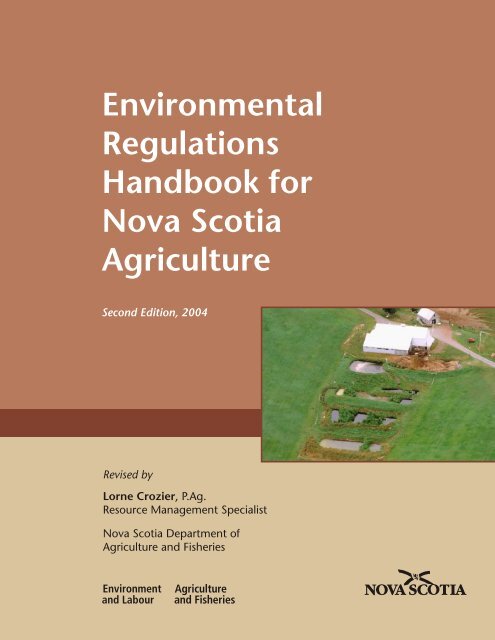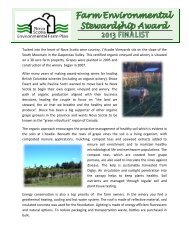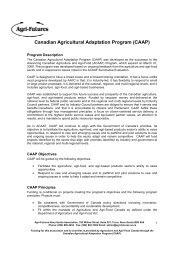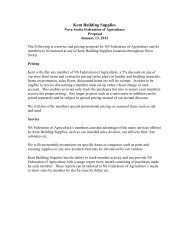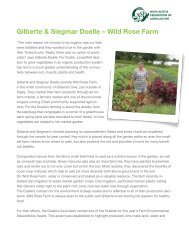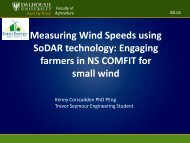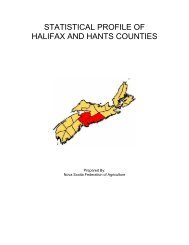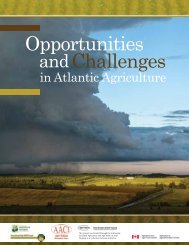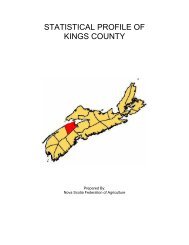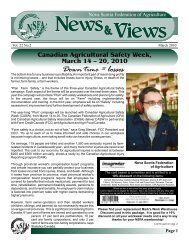Environmental Regulations Handbook for Nova Scotia Agriculture
Environmental Regulations Handbook for Nova Scotia Agriculture
Environmental Regulations Handbook for Nova Scotia Agriculture
Create successful ePaper yourself
Turn your PDF publications into a flip-book with our unique Google optimized e-Paper software.
<strong>Environmental</strong><br />
<strong>Regulations</strong><br />
<strong>Handbook</strong> <strong>for</strong><br />
<strong>Nova</strong> <strong>Scotia</strong><br />
<strong>Agriculture</strong><br />
Second Edition, 2004<br />
Revised by<br />
Lorne Crozier, P.Ag.<br />
Resource Management Specialist<br />
<strong>Nova</strong> <strong>Scotia</strong> Department of<br />
<strong>Agriculture</strong> and Fisheries
<strong>Environmental</strong> <strong>Regulations</strong><br />
<strong>Handbook</strong><br />
<strong>for</strong><br />
<strong>Nova</strong> <strong>Scotia</strong> <strong>Agriculture</strong><br />
Revised by: Lorne Crozier P.Ag.<br />
Resource Management Specialist<br />
<strong>Nova</strong> <strong>Scotia</strong> Department of <strong>Agriculture</strong> and Fisheries<br />
Acknowledgements<br />
This edition is an update of the original written by Dennis Moerman<br />
January 13, 1997.<br />
Cooperation and ef<strong>for</strong>ts of the staff of the Department of <strong>Agriculture</strong> and Fisheries,<br />
Department of Environment and Labour, Service <strong>Nova</strong> <strong>Scotia</strong> and Municipal Relations,<br />
and Department of Natural Resources, are greatly appreciated.<br />
<strong>Environmental</strong> <strong>Regulations</strong> <strong>Handbook</strong> <strong>for</strong> <strong>Nova</strong> <strong>Scotia</strong> <strong>Agriculture</strong><br />
1
Legislation Cited<br />
The following pieces of Legislation and their accompanying regulations are referred to in<br />
this version of the <strong>Environmental</strong> <strong>Regulations</strong> <strong>Handbook</strong> <strong>for</strong> <strong>Nova</strong> <strong>Scotia</strong> <strong>Agriculture</strong>.<br />
Federal:<br />
– Canadian <strong>Environmental</strong> Protection Act<br />
(Environment Canada)<br />
– Canadian <strong>Environmental</strong> Assessment Act<br />
(Environment Canada)<br />
– Species at Risk Act (Environment Canada)<br />
– Fisheries Act (Fisheries and Oceans Canada)<br />
– Navigable Waters Protection Act (Transport<br />
Canada)<br />
– Pest Control Products Act ( Health Canada)<br />
Provincial:<br />
– <strong>Agriculture</strong> Administration Amendment<br />
(2002) Act (NS Department of <strong>Agriculture</strong><br />
and Fisheries)<br />
– Agricultural Marshland Conservation Act (NS<br />
Department of <strong>Agriculture</strong> and Fisheries)<br />
– Conservation Easements Act (NS Department<br />
of Natural Resources)<br />
– Ditches and Water Courses Act (Services<br />
<strong>Nova</strong> <strong>Scotia</strong> and Municipal Relations)<br />
– Endangered Species Act (NS Department of<br />
Natural Resources)<br />
– Environment Act (NS Department of<br />
Environment and Labour)<br />
– Farm Practices Act (NS Department of<br />
<strong>Agriculture</strong> and Fisheries)<br />
– Fences and Detention of Stray Livestock Act<br />
(NS Department of <strong>Agriculture</strong> and<br />
Fisheries)<br />
– Fences and Impounding of Animals Act<br />
(Service <strong>Nova</strong> <strong>Scotia</strong> and Municipal<br />
Relations)<br />
– Forests Act (NS Department of Natural<br />
Resources)<br />
– Health Act (NS Department of Health)<br />
– Municipal Government Act (Service <strong>Nova</strong><br />
<strong>Scotia</strong> and Municipal Relations)<br />
– Special Places Protection Act (NS Department<br />
of Education)<br />
– Wilderness Area Protection Act (NS<br />
Department of Environment and Labour)<br />
These acts may be viewed on the internet at http://www.gov.ns.ca/legi/legc/index.htm .<br />
This site contains links to full texts of the statutes and regulations of <strong>Nova</strong> <strong>Scotia</strong>, as well as<br />
a link to federal legislation.<br />
<strong>Environmental</strong> <strong>Regulations</strong> <strong>Handbook</strong> <strong>for</strong> <strong>Nova</strong> <strong>Scotia</strong> <strong>Agriculture</strong><br />
3
TABLE OF CONTENTS<br />
Page<br />
Chapter 1 – Introduction.....................7<br />
1.1 Canadian <strong>Environmental</strong><br />
Assessment Act .............................. 7<br />
1.2 Important Notices.......................... 7<br />
Page<br />
CHAPTER 7 – Livestock Production<br />
7.1 Livestock Facilities ....................... 17<br />
7.2 Stocking Density.......................... 17<br />
7.3 Fencing and Restraint.................. 17<br />
CHAPTER 2 – Planning to Reduce<br />
<strong>Environmental</strong> Impact<br />
2.1 <strong>Environmental</strong> Farm Plans ............ 8<br />
CHAPTER 3 – Water Use and<br />
Management<br />
3.1 Water Supply.................................. 9<br />
3.1.1 Wells .............................................. 9<br />
3.1.2 Ponds ........................................... 10<br />
3.2 Ditches and Watercourses ........... 10<br />
3.3 Wetlands ...................................... 10<br />
3.4 Dykelands .................................... 11<br />
3.5 Watercourse Protection................ 11<br />
3.6 Livestock Access to Water<br />
Bodies ........................................... 11<br />
3.7 Designation of Watersheds ......... 12<br />
CHAPTER 4 – Farm Waste Management<br />
4.1 Solid Waste .................................. 13<br />
4.1.1 Dumps.......................................... 13<br />
4.1.2 Designated Materials ................... 13<br />
4.1.3 Burning ........................................ 13<br />
4.2 Liquid Waste ................................ 14<br />
4.2.1 Storage and Disposal of<br />
Used Oil ....................................... 14<br />
CHAPTER 8 – Soil Management ........18<br />
CHAPTER 9 – Petroleum Storage and<br />
Hangling<br />
9.1 Storage and Handling .................. 19<br />
9.2 Spills ............................................. 19<br />
CHAPTER 10 – Pesticides ................... 20<br />
10.1 Storage.......................................... 21<br />
10.2 Handling and Application ........... 21<br />
10.3 Disposal........................................ 21<br />
10.4 Spills ............................................. 21<br />
CHAPTER 11 – Nuisance<br />
11.1 Farm Practices .............................. 22<br />
CHAPTER 12 – Energy Efficiency...... 23<br />
CHAPTER 13 – Wildlife Management<br />
13.1 Endangered Species ..................... 23<br />
13.2 Wildlife Habitat ........................... 23<br />
CHAPTER 5 – Manure Storage,<br />
Handling and Use<br />
5.1 Manure Storage ............................ 15<br />
CHAPTER 6 – Fertilizer<br />
6.1 Storage.......................................... 16<br />
6.2 Spills ............................................. 16<br />
CHAPTER 14 – Air Quality<br />
14.1 Air Quality ................................... 24<br />
CHAPTER 15 – Natural Areas<br />
Conservation<br />
15.1 Special Places Designation .......... 25<br />
<strong>Environmental</strong> <strong>Regulations</strong> <strong>Handbook</strong> <strong>for</strong> <strong>Nova</strong> <strong>Scotia</strong> <strong>Agriculture</strong><br />
5
CHAPTER 1<br />
INTRODUCTION<br />
The purpose of this handbook is to provide guidance to agricultural producers of the<br />
environmental regulations, standards, codes and guidelines which affect, or may affect<br />
decisions made in the management of their farm. The in<strong>for</strong>mation contained in this<br />
handbook is a synthesis of the material contained in the various acts and regulations cited.<br />
The various sections of this handbook are organized by agricultural activity.<br />
The handbook is structured with each section and/or subsection representing an agricultural<br />
activity. Under each activity, the regulations, standards, codes and/or guidelines which apply<br />
are described.<br />
While it is recognized that municipal jurisdiction also affects many aspects of agriculture,<br />
individual municipal by-laws are not included due to the large number of municipalities<br />
and by-laws that exist, as well as the difficulty in tracking all of the changes that can occur<br />
over a period of time. They are there<strong>for</strong>e outside the scope of the present document.<br />
1.1 Canadian <strong>Environmental</strong><br />
Assessment Act<br />
The Canadian <strong>Environmental</strong> Assessment<br />
Act (CEAA) requires federal decision makers<br />
to consider the environmental effects of<br />
proposed projects be<strong>for</strong>e taking any actions<br />
that would allow the project to go ahead. The<br />
Act often applies to private sector projects<br />
where there are specific federal decisions or<br />
approvals that must be made or granted. For<br />
example, if an agriculture producer requires<br />
an approval under the Fisheries Act or<br />
Navigable Waters Protection Act <strong>for</strong> a water<br />
intake structure, the CEAA also applies and<br />
a federal environmental screening is needed.<br />
Permits or approvals under other federal<br />
legislation may also trigger the CEAA.<br />
Applying <strong>for</strong> federal funding to enable an<br />
agricultural producer to carry out a project,<br />
is subject to CEAA. If acquisition or lease of<br />
federal land is needed <strong>for</strong> the project to<br />
proceed, the project is subject to CEAA.<br />
When the CEAA applies, the agricultural<br />
producer may be asked to provide in<strong>for</strong>mation<br />
or prepare an environmental<br />
assessment <strong>for</strong> their proposed project. For<br />
further in<strong>for</strong>mation on the Act, or advice on<br />
whether it applies to your project or activities,<br />
please contact the Canadian <strong>Environmental</strong><br />
Assessment Agency, Atlantic<br />
Region at (902) 426-0564.<br />
Where both a federal and provincial<br />
environmental assessment are required <strong>for</strong><br />
the same project, the two governments work<br />
together in a harmonized manner.<br />
1.2 Important Notices<br />
This document was prepared under the<br />
direction of the <strong>Nova</strong> <strong>Scotia</strong> Department of<br />
<strong>Agriculture</strong> and Fisheries. Although every<br />
ef<strong>for</strong>t has been made to ensure the accuracy<br />
of its contents, the Department of <strong>Agriculture</strong><br />
and Fisheries assumes no liability <strong>for</strong><br />
the accuracy or reliability of the in<strong>for</strong>mation<br />
contained herein. It must be recognized by<br />
the user of this handbook that acts,<br />
regulations, by-laws, standards, codes and<br />
guidelines are constantly changing. Users of<br />
this handbook are recommended to<br />
contact the regulating agency <strong>for</strong> further<br />
in<strong>for</strong>mation on laws, regulations or bylaws<br />
which may affect their operations.<br />
<strong>Environmental</strong> <strong>Regulations</strong> <strong>Handbook</strong> <strong>for</strong> <strong>Nova</strong> <strong>Scotia</strong> <strong>Agriculture</strong><br />
7
Reproduction in whole or in part by any<br />
means is permitted, subject to the following<br />
restrictions:<br />
Physical copies must not be sold.<br />
The author and the Department must be<br />
acknowledged as the source on all copies.<br />
Translations and modifications are not<br />
permitted.<br />
Other requests <strong>for</strong> permission to re-publish<br />
should be addressed to:<br />
<strong>Nova</strong> <strong>Scotia</strong> Department of <strong>Agriculture</strong> and<br />
Fisheries, Resource Stewardship Division<br />
P.O. Box 550, Truro<br />
<strong>Nova</strong> <strong>Scotia</strong> B2N 5E3<br />
att: <strong>Regulations</strong> <strong>Handbook</strong><br />
CHAPTER 2<br />
PLANNING TO REDUCE ENVIRONMENTAL IMPACT<br />
Introduction<br />
Various agricultural activities have the potential to pollute or damage the environment. It<br />
should also be evident from the following chapters that there are a number of laws,<br />
regulations, standards, codes and guidelines that regulate agricultural activities as they interact<br />
with the environment. It is the intent of this handbook to help farmers be aware of these<br />
ordinances so that they can be proactive in the way they practice agriculture. Farmers can<br />
also take practical actions in managing their operations in order to reduce the risk of causing<br />
environmental damage and be in compliance with the law.<br />
2.1 <strong>Environmental</strong> Farm Plans<br />
(EFP)<br />
In order to be pro-active the <strong>Nova</strong> <strong>Scotia</strong><br />
Federation of <strong>Agriculture</strong> and the NS<br />
Department of <strong>Agriculture</strong> and Fisheries have<br />
developed an <strong>Environmental</strong> Farm Plan<br />
Program. This program is voluntary and its<br />
goal is to help farmers identify and assess<br />
environmental risk by examining their farm<br />
operation from an environmental management<br />
perspective. It allows farmers to<br />
incorporate environmental considerations<br />
into their business decision making process<br />
rather than addressing environmental issues<br />
on a stop gap basis.<br />
The EFP program was initiated in 1997 and<br />
modified in 1999. The program includes the<br />
following components:<br />
1. Initial farm visit<br />
2. On farm environmental review by an<br />
Agricultural Engineer<br />
3. Documentation of the review findings<br />
4.Presentation of the findings and an<br />
environmental farm plan (all aspects of the<br />
process are kept confidential)<br />
5. Follow-up visit<br />
Included in the assessment is a consideration<br />
of water use and management, farm waste<br />
management, manure storage and handling,<br />
fertilizer management and livestock production,<br />
pest management practices,<br />
pesticide storage and application practices.<br />
The <strong>Environmental</strong> Farm Plan is voluntary<br />
at this time. It is recommended that farmers<br />
participate in this program. For further<br />
in<strong>for</strong>mation regrading this program, contact<br />
the <strong>Nova</strong> <strong>Scotia</strong> Federation of <strong>Agriculture</strong> or<br />
your local Agricultural Resource Coordinator.<br />
8 <strong>Environmental</strong> <strong>Regulations</strong> <strong>Handbook</strong> <strong>for</strong> <strong>Nova</strong> <strong>Scotia</strong> <strong>Agriculture</strong>
Introduction<br />
CHAPTER 3<br />
WATER USE AND MANAGEMENT<br />
Water is a valuable resource which we must share with other people and with the ecosystem<br />
in which we live. The agricultural industry is highly dependant on a quality source of water<br />
<strong>for</strong> many aspects of production, whether it be <strong>for</strong> growing crops, livestock, <strong>for</strong> sanitation of<br />
equipment or application of pest control products. As with any industry or human activity,<br />
agricultural practices have the potential to adversely impact water quality. The following<br />
describes the legislation which helps to protect and regulate the use of this valuable resource.<br />
3.1 Water Supply<br />
3.1.1 Wells<br />
An approval from the NS Department of<br />
Environment and Labour is required <strong>for</strong> the<br />
withdrawal or diversion of more than 23,000<br />
L of water per day from any surface or<br />
groundwater source (Environment Act (NS),<br />
Activities Designation <strong>Regulations</strong>. Should<br />
the water be extracted from a surface water<br />
supply, the intake must be screened as per<br />
the federal Fisheries Act.<br />
The Well Construction <strong>Regulations</strong> of the<br />
Environment Act (NS) regulate all aspects of<br />
the construction, maintenance and<br />
abandonment of wells. It is mandatory that<br />
drilled well construction be carried out by a<br />
licensed well contractor. However, if a<br />
producer were to dig their own well, the well<br />
construction must meet all the requirements<br />
<strong>for</strong> the Well Construction <strong>Regulations</strong>,<br />
which include the following items:<br />
1. During construction or maintenance all<br />
debris should be removed from within and<br />
around the well, and the well must be<br />
disinfected using a method approved by<br />
an inspector.<br />
2. No wells can be built in such a manner or<br />
location that surface water may enter the<br />
well or aquifer.<br />
3.Wells must be located at minimum<br />
specified distances from potential contaminant<br />
sources as follows:<br />
– 61 m from a cesspool receiving raw sewage<br />
(this applies to manure storage<br />
lagoons)<br />
– 15.2 m (drilled well) or 30.5 m (dug well)<br />
from a seepage (leaching) pit, filter bed,<br />
soil adsorption field, earth pit, privy, or<br />
similar disposal unit; septic tank, concrete<br />
vault privy, sewer of tightly joined tile or<br />
equivalent material or sewer connected<br />
foundation drain<br />
– 3 m from a sewer of cast iron with leaded<br />
or approved mechanical joints, independent<br />
clear water drain or cistern<br />
– 610 mm from a pump house floor drain,<br />
cast iron with leaded joints, draining to<br />
ground surface<br />
– 1.5 m of a property boundary<br />
– 6.1 m from the outer boundary of any road<br />
or public highway unless approved by an<br />
inspector<br />
It is recommended that the “Guidelines <strong>for</strong><br />
the Management and Use of Animal Manure<br />
in <strong>Nova</strong> <strong>Scotia</strong>” be consulted <strong>for</strong> separation<br />
distances from wells and manure spreading<br />
operations.<br />
Wells must be maintained to ensure they do<br />
not pose a safety or environmental hazard.<br />
Abandoned or unused wells must be sealed<br />
to prevent the vertical movement of water<br />
into the well, and wells maintained <strong>for</strong> future<br />
use must be sealed in a manner approved by<br />
an NSDEL inspector.<br />
For additional details on well abandonment<br />
procedures, consult your local NSDEL office.<br />
<strong>Environmental</strong> <strong>Regulations</strong> <strong>Handbook</strong> <strong>for</strong> <strong>Nova</strong> <strong>Scotia</strong> <strong>Agriculture</strong><br />
9
3.1.2 Ponds<br />
An approval from the NS Department of<br />
Environment and Labour is required <strong>for</strong> the<br />
storage of more than 25,000 m 3 of water<br />
(Environment Act, (NS), Activities Designation<br />
<strong>Regulations</strong> . This would cover most<br />
agricultural ponds.<br />
When extracting water from a water body<br />
(stream, lake or pond) that may contain fish,<br />
the federal Fisheries Act requires that the<br />
pump intake be screened to prevent fish from<br />
being drawn into the pump.<br />
There is also a requirement <strong>for</strong> maintenance<br />
of a minimum flow in the watercourse, and<br />
an assessment to ensure that the water<br />
withdrawal rate will not exceed the capability<br />
of the watercourse.<br />
3.2 Ditches and Watercourses<br />
An approval from the NS Department of<br />
Environment and Labour is required <strong>for</strong> the<br />
construction or maintenance of a dam, the<br />
removal of material from a surface<br />
watercourse, the diversion of a watercourse<br />
from its natural channel, the dredging or<br />
modification of a surface watercourse, the<br />
placement of rock or other erosion control<br />
material in a surface water course, or any<br />
other alteration of a surface watercourse or<br />
the flow of water. Other alterations would<br />
include stream crossings/<strong>for</strong>ds. (Environment<br />
Act (NS), Activities Designation<br />
<strong>Regulations</strong>.<br />
An environmental assessment is required <strong>for</strong><br />
a project which involves the transfer of water<br />
between drainage basins where the drainage<br />
area to be diverted is greater than 1 km 2<br />
(Environment Act (NS) <strong>Environmental</strong><br />
Assessment <strong>Regulations</strong>). In this act<br />
“watershed” means the area drained by, or<br />
contributing to a stream, lake or other body<br />
of water. It is possible <strong>for</strong> larger farms, or<br />
farms which have land holdings in more<br />
than one location to be part of two or more<br />
watersheds.<br />
An approval is required <strong>for</strong> the construction<br />
of any dam or obstruction of a watercourse<br />
or any other construction which alters the<br />
watercourse, or may affect the watercourse<br />
and/or the quality of the water or fish habitat<br />
as per the federal Fisheries Act. If such a<br />
construction obstructs the movement of fish,<br />
the construction of a fish way may be<br />
required by Fisheries and Oceans Canada<br />
(Fisheries Act).<br />
Under the Environment Act (NS) a manmade<br />
ditch is not a water course.<br />
Some municipalities have by-laws specifying<br />
buffer strips along streams. Check with the<br />
municipal office in your area to determine if<br />
by-laws regarding buffer strips are in effect.<br />
The Ditches and Water Courses Act (Service<br />
<strong>Nova</strong> <strong>Scotia</strong> and Municipal Relations)<br />
provides <strong>for</strong> agreements between land<br />
owners to build, widen or deepen ditches to<br />
remove run off from their properties. The<br />
agreements apply to new owners of the same<br />
lands until the municipally appointed<br />
engineer decides otherwise. The ditch<br />
cannot affect other owners’ lands without<br />
their consent. The Act provides dispute<br />
resolution mechanisms <strong>for</strong> disputes between<br />
owners who have entered into these<br />
agreements. The municipal clerk is the<br />
contact person in the case of disputes.<br />
3.3 Wetlands<br />
The “Wetlands Directive” of the NS<br />
Department of Environment and Labour<br />
states that an area which is in active<br />
agricultural use, dykeland, existing cranberry<br />
bog 1 , etc., is not a wetland <strong>for</strong> the purposes<br />
of the Act and its regulations. The following<br />
provisions, there<strong>for</strong>e would not apply to<br />
these areas.<br />
1<br />
Note: The term cranberry bog refers to a man<br />
made structure which is only flooded under<br />
controlled conditions as part of cranberry crop<br />
management.<br />
10 <strong>Environmental</strong> <strong>Regulations</strong> <strong>Handbook</strong> <strong>for</strong> <strong>Nova</strong> <strong>Scotia</strong> <strong>Agriculture</strong>
An environmental assessment under the NS<br />
Department of Environment and Labour is<br />
required <strong>for</strong> any activity which disrupts 2 ha<br />
or more of any wetland (Environment Act,<br />
<strong>Environmental</strong> Assessment <strong>Regulations</strong><br />
schedule “A” F.2). An approval from the NS<br />
Department of Environment and Labour is<br />
required <strong>for</strong> any activity which takes place<br />
on or may disrupt any wetland of less than 2<br />
ha (Environment Act, Activities Designation<br />
<strong>Regulations</strong>).<br />
Alteration of a water course by activities<br />
related to wood lot management, and other<br />
activities such as stream crossings, the<br />
placement of rock or other erosion protection<br />
material in a surface watercourse; or any other<br />
alteration of a surface watercourse or the flow<br />
of the water therein, is designated as an<br />
activity under the provincial Environment<br />
Act, Activities Designation <strong>Regulations</strong>.<br />
This requires an approval from the NS<br />
Department of Environment and Labour<br />
3.4 Dykelands<br />
Dykelands are regulated under the provincial<br />
Agricultural Marshland Conservation Act.<br />
Under this act, no development shall, on<br />
and after November 7, 2000, be carried out<br />
in a marshland section unless authorized by<br />
the Marshland Administrator or the<br />
development con<strong>for</strong>ms with generally<br />
accepted farming practices that do not<br />
require structures to be built. “Development”<br />
includes the erection, construction, alteration,<br />
placement, location, replacement or<br />
relocation of, or addition to, a structure or a<br />
change or alteration in the use made of lands<br />
or structures.<br />
There is an exemption under the<br />
Environment Act, Activities Designations<br />
<strong>Regulations</strong> that any development must be<br />
approved by the Marsh Body (board<br />
appointed to administer the marsh).<br />
3.5 Watercourse Protection<br />
<strong>Regulations</strong> have been added to the Forests<br />
Act, Wildlife Habitat and Watercourses<br />
Protection <strong>Regulations</strong>, which must be<br />
followed when <strong>for</strong>est harvesting takes place<br />
on any woodland in <strong>Nova</strong> <strong>Scotia</strong>. These<br />
require: 1. Leaving buffer strips (special<br />
management zones) along water-courses,<br />
2. Leaving legacy trees/wildlife clumps,<br />
3. Leaving coarse woody debris. The first<br />
requirement applies to the protection of<br />
watercourses.<br />
3.6 Livestock Access To Natural<br />
Water Bodies<br />
Over the past many years people have<br />
become more aware of the impact that<br />
livestock operations can have on the natural<br />
environment. Complaints over cattle having<br />
access to, or standing in, streams and rivers<br />
have become more frequent. While there is<br />
no law that specifically says “you shall not<br />
allow your cattle to enter a natural water<br />
body”, there are several laws which in effect<br />
say this in other ways. The key ones among<br />
these are:<br />
1. The federal Fisheries Act states that no<br />
person shall alter fish habitat without<br />
approval and “no person shall deposit or<br />
permit the deposit of a deleterious substance<br />
of any type in water frequented by<br />
fish” or where the substance may enter<br />
water frequented by fish.<br />
2. The provincial Environment Act also<br />
basically says that no one can release<br />
(knowingly or not) into the environment<br />
a substance that causes or may cause a<br />
significant adverse effect.<br />
These laws are significant because the<br />
bacteria and nutrients from the feces and<br />
urine of cattle qualify as deleterious<br />
substances that may cause a significant<br />
adverse effect. Almost all of our waters are<br />
frequented by fish or flow into areas<br />
frequented by fish. As well, the uncontrolled<br />
trampling of cattle on the banks of streams<br />
<strong>Environmental</strong> <strong>Regulations</strong> <strong>Handbook</strong> <strong>for</strong> <strong>Nova</strong> <strong>Scotia</strong> <strong>Agriculture</strong><br />
11
and on stream bottoms can disturb soil and<br />
stream sediments leading to siltation. Silt is<br />
also deemed a deleterious substance under<br />
the federal Fisheries Act.<br />
If you are a livestock producer and your cattle<br />
currently have access to a natural water body<br />
(stream, river, brook, lake, natural pond, or<br />
natural wetland) then there are a few steps<br />
you should take.<br />
1. You should restrict your cattle’s access to<br />
the natural water body using some <strong>for</strong>m<br />
of fencing.<br />
2.You should invest in an alternative<br />
watering system <strong>for</strong> your cattle.<br />
3. If your cattle must cross a natural water<br />
body to get from one field to another, you<br />
should construct a properly designed and<br />
permitted stream crossing. This activity<br />
requires an approval from the NS<br />
Department of Environment and Labour<br />
(Environment Act, Activities Designation<br />
<strong>Regulations</strong>) and approved by the<br />
Fisheries and Oceans Canada). Fisheries<br />
and Oceans Canada has a useful brochure<br />
on their website at http://www.dfompo.gc.ca/habitat/law_req/index_e.asp<br />
entitled “Fish Habitat Conservation and<br />
Protection - What The Law Requires”<br />
which explains section 35 (2) of the federal<br />
Fisheries Act on habitat alterations and<br />
approvals.<br />
3.7 Designation of Protected<br />
Water Areas<br />
Protected Water Areas may be applied to<br />
surface water supply areas as well as ground<br />
water supply areas.<br />
Under the Environment Act (NS), The<br />
Minister, when requested by an operator of<br />
a water works or proposed water works, may<br />
designate an area surrounding any source or<br />
future source of water supply <strong>for</strong> a water<br />
works as a protected water area. This allows<br />
water utility owners to restrict activities<br />
including agriculture in a designated<br />
watershed. Setbacks and other restrictions<br />
may also apply. While it is advised that water<br />
utility owners purchase all land within a<br />
designated watershed, there may be some<br />
cases where this is not possible. Guidelines<br />
have been prepared <strong>for</strong> agricultural practices<br />
within designated water sheds. Refer to<br />
Recommended Agricultural Practices<br />
within Municipal Drinking Water Supply<br />
Areas in <strong>Nova</strong> <strong>Scotia</strong>.<br />
12 <strong>Environmental</strong> <strong>Regulations</strong> <strong>Handbook</strong> <strong>for</strong> <strong>Nova</strong> <strong>Scotia</strong> <strong>Agriculture</strong>
Introduction<br />
CHAPTER 4<br />
FARM WASTE MANAGEMENT<br />
There are a number of waste products which are produced or accumulated by any farm<br />
operation. These include solid wastes such as plastics, wood, brush, twine and liquid wastes<br />
such as milkhouse washwater, silage leachate and used oil. The following outlines legislation<br />
which regulate the disposal of these wastes. Animal wastes and pesticide wastes will be<br />
dealt with in separate sections.<br />
4.1 Solid Waste<br />
The Solid Waste Resource Management<br />
<strong>Regulations</strong> of the provincial Environment<br />
Act regulate the way in which solid wastes<br />
generated on the farm can be disposed of.<br />
The following sections summarize these<br />
regulations.<br />
4.1.1 Dumps<br />
Under the Solid Waste Resource<br />
Management <strong>Regulations</strong> (NS Department<br />
Environment and Labour), it is illegal to<br />
“own, construct, manage, operate, alter or<br />
modify a landfill, incinerator, ash disposal<br />
site, or disposal site <strong>for</strong> construction or<br />
demolition debris without obtaining<br />
approval from the Minister”. This means that<br />
it is generally illegal to dump solid wastes<br />
on the farm. Some exceptions to this outlined<br />
in the regulations are:<br />
“rock (excluding rock containing a<br />
sulphide bearing material), aggregate, soil<br />
bricks, mortar, concrete, asphalt, pavement,<br />
porcelain or ceramic materials, tress,<br />
brush, limbs, stumps, root balls, organic<br />
mat, and milled wood that is free of<br />
adhesives, coatings or preservatives”.<br />
4.1.2 Designated Materials<br />
The Solid Waste Resource Management<br />
<strong>Regulations</strong> identify a number of designated<br />
materials which are banned from landfills.<br />
The list of materials includes the following,<br />
which are taken from Schedule B of the<br />
regulations.<br />
• Redeemed beverage containers – Ethylene<br />
glycol (automotive antifreeze)<br />
• Corrugated cardboard – Compostable<br />
organic material<br />
• Newsprint – Steel/tin food containers<br />
• Used tires – Glass food containers<br />
• Lead-acid (automotive) batteries – Lowdensity<br />
polyethylene bags and packaging<br />
• Leaf and yard waste – High-density<br />
polyethylene bags and<br />
• Waste paint – packaging<br />
This requires that you find alternative<br />
methods of disposing of these materials such<br />
as recycling, composting, or returning to<br />
place of purchase as appropriate.<br />
4.1.3 Burning<br />
There is a prohibition on the burning of tires,<br />
waste dangerous goods, used oil, materials<br />
containing rubber or plastic, railway ties or<br />
other woods treated with preservative and<br />
asphalt shingles in the provincial<br />
Environment Act, Air Quality <strong>Regulations</strong>,<br />
Schedule “B”. As a result, tires, used oil, etc.<br />
may not be burned or used to facilitate the<br />
burning of brush piles.<br />
The burning of municipal solid wastes is also<br />
prohibited under the Environment Act,<br />
Solid Waste Resource Management<br />
<strong>Regulations</strong>. “Municipal solid waste” means<br />
garbage, refuse, sludge, rubbish, tailings,<br />
debris, litter and other discarded materials<br />
resulting from residential, commercial,<br />
institutional and industrial activities which<br />
are commonly accepted at a municipal solid<br />
<strong>Environmental</strong> <strong>Regulations</strong> <strong>Handbook</strong> <strong>for</strong> <strong>Nova</strong> <strong>Scotia</strong> <strong>Agriculture</strong><br />
13
waste management facility, but excludes<br />
wastes from industrial activities regulated by<br />
an approval issued under the Act.<br />
Various permits may be required be<strong>for</strong>e<br />
undertaking burning operations on your<br />
farm such as disposal of brush piles or<br />
burning of blueberry fields. You are advised<br />
to check with your municipal office to<br />
determine if municipal burning permits are<br />
required.<br />
Under the Forest Fire Protection <strong>Regulations</strong><br />
of the provincial Forests Act, a burning<br />
permit from the Department of Natural<br />
Resources is required to “set, start, kindle or<br />
maintain a fire in the woods or within 1000<br />
ft of the woods” during the <strong>for</strong>est fire season 1 .<br />
Please consult with your local office of the<br />
Department of Natural Resources to<br />
determine the type of permit and specific<br />
conditions and stipulations which apply in<br />
your situation. Also note that permits are<br />
sometimes required from both the<br />
Department of Natural Resources and the<br />
Municipality.<br />
1<br />
The <strong>for</strong>est fire season <strong>for</strong> Yarmouth, Digby,<br />
Shelburne, Kings, Annapolis, Queens and<br />
Lunenburg is April 1st through October 15th<br />
inclusive. For All other counties it is April 15th<br />
through October 15th inclusive.<br />
4.2 Liquid Waste<br />
Many liquid wastes, such as milkhouse wash<br />
water, silage leachate, field runoff, etc.,<br />
generated by the farm are not specifically<br />
regulated. However, liquid wastes released<br />
into the environment, ie applied to land,<br />
entering surface or groundwater in levels<br />
considered to be deleterious could trigger<br />
charges under four separate pieces of<br />
legislation, the Canadian <strong>Environmental</strong><br />
Protection Act (CEPA), the federal Fisheries<br />
Act, the Health Act (NS), or the Environment<br />
Act (NS). These wastes should be contained,<br />
handled and disposed of in a manner which<br />
prevents their entry into surface or<br />
groundwater.<br />
The following section outlines specific liquid<br />
wastes <strong>for</strong> which regulations do exist (note<br />
manure and pesticides are discussed in<br />
CHAPTERs 5 and 10).<br />
4.2.1 Storage and Disposal of<br />
Used Oil<br />
Used oil should be safely stored as per the<br />
requirements defined in the NS Department<br />
of Environment and Labour’s Guidelines <strong>for</strong><br />
the Storage of Used Oil. The disposal of used<br />
oil is regulated by the Used Oil <strong>Regulations</strong><br />
under the provincial Environment Act.<br />
Under these regulations, used oil is defined<br />
as petroleum or synthetic lubrication oils,<br />
hydraulic fluids, metal working fluids and<br />
insulating fluids which have been used and<br />
are no longer suitable <strong>for</strong> their original<br />
purpose, but are suitable <strong>for</strong> other uses,<br />
including re-refining or other uses that are<br />
considered acceptable to the Minister.<br />
Contaminated used oil is defined as used oil<br />
that has a flash point less than 38 0 C or<br />
contains any of the substances listed in<br />
Column I of Schedule “A” in a concentration<br />
in excess of the limit stated in Column II of<br />
Schedule “A” of the Used Oil <strong>Regulations</strong>.<br />
The chief contaminants of concern include<br />
PCBs, Total Organic Halocarbons (as<br />
chlorine), cadmium, chromium, and lead.<br />
Under these regulations the following<br />
restrictions apply:<br />
1. Used oil or contaminated used oil must be<br />
disposed of by transfer to a NSDEL licenced<br />
used oil collector or an NSDEL approved<br />
used oil storage facility.<br />
2. Used crankcase oil may also be returned<br />
to a used oil return facility (volume<br />
limitations may apply – check with the<br />
seller of the crankcase oil <strong>for</strong> locations of<br />
return facilities)<br />
3. Used crankcase oil generated on site may<br />
be burned only in NSDEL registered used<br />
oil furnaces.<br />
14 <strong>Environmental</strong> <strong>Regulations</strong> <strong>Handbook</strong> <strong>for</strong> <strong>Nova</strong> <strong>Scotia</strong> <strong>Agriculture</strong>
4. Used oil may NOT be applied to “a public<br />
or private highway, road, lane, trail, bridge,<br />
parking area or any land <strong>for</strong> any purpose<br />
including dust suppression”.<br />
Under the Emergency Spill <strong>Regulations</strong>,<br />
Schedule “A” spills of used oil greater than<br />
100 Litres or spills of contaminated used oil<br />
greater than 5 Litres must be reported by<br />
calling the environmental emergencies<br />
centre at 1-800-565-1633. Following the<br />
reporting of a spill, the person responsible<br />
<strong>for</strong> the petroleum storage must provide all<br />
in<strong>for</strong>mation required by the emergency<br />
responder from the NS Department of<br />
Environment and Labour and must comply<br />
with all orders issued under the Emergency<br />
Spill <strong>Regulations</strong>.<br />
Introduction<br />
CHAPTER 5<br />
MANURE STORAGE HANDLING AND USE<br />
Proper management of manure storages and manure spreading can decrease the potential<br />
<strong>for</strong> odour generation and environmental pollution. Manure storage is a necessary part of<br />
livestock production, since incorporation of manure into the soil or spreading on the soil<br />
should only be done at certain times of the year. The following legislation and guidelines<br />
apply to all livestock operations including beef, dairy, sheep, goat, turkey, layer, swine, broiler,<br />
hogs and mink where the storage, handling and use of animal manure constitutes a significant<br />
component of the farm operation.<br />
Livestock manure has the potential to contaminate both surface water and groundwater<br />
supplies. Manure entering surface water or groundwater in levels considered to be deleterious<br />
could trigger charges under four separate pieces of legislation, the Canadian <strong>Environmental</strong><br />
Protections Act (CEPA), the federal Fisheries Act, the Health Act (NS), or the Environment<br />
Act (NS). Manure should be contained, handled and applied in a manner which prevents its<br />
entry into surface water or groundwater.<br />
5.1 Manure Storage<br />
In general, the storage of manure is not<br />
regulated under Federal or Provincial Statutes<br />
at present. However, an environmental<br />
assessment through the NS Department of<br />
Environment and Labour is required on any<br />
storage holding more than 5000 m 3 of liquid<br />
or gaseous substances, which would include<br />
liquid manure (Environment Act,<br />
<strong>Environmental</strong> Assessment <strong>Regulations</strong>).<br />
Under Municipal by-laws, the location of<br />
manure storages, as well as setback distances<br />
from neighbouring properties and or streams,<br />
may be regulated. For in<strong>for</strong>mation on<br />
setbacks within your community, please<br />
contact your municipal office <strong>for</strong> by-law<br />
in<strong>for</strong>mation.<br />
Where specific by-laws do not exist it is<br />
recommended that the setbacks in the<br />
“Guidelines <strong>for</strong> the Management and Use<br />
of Animal Manure in <strong>Nova</strong> <strong>Scotia</strong>” be<br />
followed.<br />
Under Municipal by-laws a development<br />
permit or building permit may be required<br />
<strong>for</strong> the construction of a manure storage. For<br />
in<strong>for</strong>mation on building permits within your<br />
community, please contact your municipal<br />
office <strong>for</strong> by-law in<strong>for</strong>mation.<br />
Also, a variance ruling would be required <strong>for</strong><br />
construction on land that is protected as<br />
marshland under the Agricultural<br />
Marshland Conservation Act (NS).<br />
<strong>Environmental</strong> <strong>Regulations</strong> <strong>Handbook</strong> <strong>for</strong> <strong>Nova</strong> <strong>Scotia</strong> <strong>Agriculture</strong><br />
15
Introduction<br />
CHAPTER 6<br />
FERTILIZER<br />
Fertilizers have the potential to be contaminants in both surface and groundwater supplies.<br />
Fertilizer entering surface or groundwater in levels considered to be deleterious could trigger<br />
charges under four separate pieces of legislation, the Canadian <strong>Environmental</strong> Protection<br />
Act (CEPA), the federal Fisheries Act, the Health Act (NS), or the Environment Act (NS).<br />
Fertilizers should be stored, handled and applied in a manner which prevents its entry into<br />
surface or groundwater.<br />
6.1 Storage<br />
Only storage of very large quantities of<br />
fertilizer, generally in excess of that used by<br />
most farms, is regulated. An approval from<br />
the NS Department of Environment and<br />
Labour is required <strong>for</strong> the construction or<br />
operation of a storage facility that has the<br />
capacity to store 250t or more of anhydrous<br />
ammonia or 500t or more of granular or<br />
prilled ammonia phosphate, ammonium<br />
nitrate or urea fertilizer products (Environment<br />
Act (NS), Activities Designation<br />
<strong>Regulations</strong>).<br />
6.2 Spills<br />
Under section 5 of the Environment Act (NS)<br />
Emergency Spill <strong>Regulations</strong> and Schedule<br />
“A” spills of 50L or 50kg or more of<br />
miscellaneous products must be reported by<br />
calling the environmental emergencies<br />
centre at 1-800-565-1633. Following the<br />
reporting of a spill, the person responsible<br />
<strong>for</strong> the fertilizer must provide all in<strong>for</strong>mation<br />
required by the emergency responder from<br />
the NS Department of Environment and<br />
Labour. As well they must comply with all<br />
orders issued under the Emergency Spill<br />
<strong>Regulations</strong>.<br />
A person responsible must also initiate<br />
containment and cleanup of a spill as soon<br />
as possible after they are aware of the spill.<br />
16 <strong>Environmental</strong> <strong>Regulations</strong> <strong>Handbook</strong> <strong>for</strong> <strong>Nova</strong> <strong>Scotia</strong> <strong>Agriculture</strong>
Introduction<br />
CHAPTER 7<br />
LIVESTOCK PRODUCTION<br />
The following section deals with legislation and regulations affecting areas of livestock<br />
production other than waste production. These include livestock facilities, stocking density<br />
and fencing regulations.<br />
7.1 Livestock Facilities<br />
Construction of livestock facilities is<br />
regulated by municipal by-laws. In most<br />
municipalities a development permit or<br />
building permit is required <strong>for</strong> the<br />
construction of a livestock facility. Be sure<br />
to consult your municipal office to find out<br />
the requirements <strong>for</strong> your location.<br />
Livestock facilities must be constructed in<br />
accordance with the “National Farm<br />
Building Code of Canada”.<br />
Location of livestock facilities may be<br />
regulated by Municipal by-laws. These<br />
control both the location (zones) in which<br />
livestock operations are permitted, and the<br />
setbacks required. If you farm in one of these<br />
municipalities, please contact your municipal<br />
office <strong>for</strong> by-law in<strong>for</strong>mation.<br />
7.2 Stocking Density<br />
Some municipalities and planning areas<br />
regulate livestock stocking densities, in<br />
planning areas, <strong>for</strong> both commercial<br />
livestock and household livestock operations.<br />
The definitions <strong>for</strong> commercial and<br />
household livestock operations as well as the<br />
various conversions <strong>for</strong> animal type vary<br />
from by-law to by-law. Refer to the current<br />
by-laws, or contact the local development<br />
officer <strong>for</strong> the pertinent definition and<br />
conversions.<br />
Where no specific municipal by-law<br />
restrictions apply it is recommended that<br />
figure 2, “Minimal Annual Hectareage<br />
Required <strong>for</strong> Manure Application” of the<br />
“Guidelines <strong>for</strong> the Management and Use<br />
of Animal Manures in <strong>Nova</strong> <strong>Scotia</strong>” be<br />
utilized.<br />
7.3 Fencing and Restraint<br />
The provincial Fences and Detention of<br />
Stray Livestock Act requires the owner of a<br />
livestock farm to build and maintain fences<br />
to prevent his livestock from escaping from<br />
the farm. It requires the owner of an<br />
adjoining non-livestock farm not to plant or<br />
cultivate any crop other than hay or pasture<br />
closer than eight feet to the livestock owner’s<br />
fence, that would constitute an enticement<br />
to livestock. The Act requires owners of<br />
adjoining livestock farms to share the costs<br />
of building and maintaining fences.<br />
Livestock means cattle, horses, ponies, mules,<br />
sheep, swine and goats. The Act applies only<br />
to municipalities designated by the Governor<br />
in Council. Sixteen municipalities were<br />
designated as of 2002. Check with your<br />
municipal office as to their status under this<br />
act.<br />
The Fences and Detention of Stray Livestock<br />
Act was amended in 2002. The changes are<br />
found in the <strong>Agriculture</strong> Administration<br />
Amendment Act.<br />
For those municipalities not designated<br />
under the previous Act, the Fences and<br />
Impounding of Animals Act (NS) requires the<br />
proprietor of a field adjoining another<br />
improved and enclosed field to build or<br />
maintain his proportion of the fencing.<br />
Fences are to be built of stones, pickets,<br />
<strong>Environmental</strong> <strong>Regulations</strong> <strong>Handbook</strong> <strong>for</strong> <strong>Nova</strong> <strong>Scotia</strong> <strong>Agriculture</strong><br />
17
oards, logs, poles, brush, posts and rails, or<br />
posts and wire, barbed or plain, unless the<br />
lands are bounded by un<strong>for</strong>dable ponds,<br />
rivers or the sea or surrounded by hedges.<br />
The fences must be at least four and a half<br />
feet high, except stone walls and picket,<br />
board and wire fences which shall be at least<br />
four feet high. Owners of wood or barren or<br />
burnt lands not under improvement are not<br />
compelled to have fences.<br />
The Act prohibits animals to run at large<br />
where a municipal bylaw prohibits it and<br />
provides <strong>for</strong> damages from the owner of an<br />
animal who breaks another’s fence. The Act<br />
provides <strong>for</strong> impounding animals. Animals<br />
means horses, asses, mules, cattle, sheep,<br />
goats and swine.<br />
The type of fencing permitted may be<br />
regulated by municipal by-law under the<br />
provisions of the Municipal Government Act<br />
(NS). Check with your municipal office to<br />
determine if by-laws are in effect.<br />
While fencing of livestock from watercourses<br />
is not currently regulated, it is the<br />
recommended practice within the<br />
“Guidelines <strong>for</strong> the Management and Use<br />
of Animal Manure in <strong>Nova</strong> <strong>Scotia</strong>”.<br />
Introduction<br />
CHAPTER 8<br />
SOIL MANAGEMENT<br />
In general, there are no specific pieces of legislation, regulations, or by-laws which deal with<br />
soil management. However, “release” of sediment into surface water can trigger charges<br />
under three separate pieces of legislation, the Canadian <strong>Environmental</strong> Protection Act<br />
(CEPA), the federal Fisheries Act, or the Environment Act (NS). In particular, Fisheries and<br />
Oceans Canada, which administers the Fisheries Act, is very concerned about sediment<br />
entering streams, particularly those which are spawning grounds <strong>for</strong> salmonoids (salmon<br />
and trout). Fisheries and Oceans Canada has set a standard of 25 mg/L of sediment in water.<br />
If water running off from your farm can be shown to exceed this amount, you may be<br />
charged under the federal Fisheries Act or the provincial Environment Act.<br />
18 <strong>Environmental</strong> <strong>Regulations</strong> <strong>Handbook</strong> <strong>for</strong> <strong>Nova</strong> <strong>Scotia</strong> <strong>Agriculture</strong>
Introduction<br />
CHAPTER 9<br />
PETROLEUM STORAGE AND HANDLING<br />
The storage, handling and disposal of petroleum products is highly regulated. Producers<br />
should be aware that virtually every aspect of the process will require compliance with some<br />
<strong>for</strong>m of regulatory control. This section will assist in identifying the issues and requirements<br />
surrounding petroleum products on the farm.<br />
9.1 Storage and Handling<br />
The management of petroleum products is<br />
regulated by the Petroleum Management<br />
<strong>Regulations</strong> under the provincial<br />
Environment Act. Under the regulations, the<br />
following general conditions apply:<br />
1. No person shall install an underground<br />
storage tank system with a capacity less<br />
than 2000 Litres.<br />
2. Steel underground tanks installed prior to<br />
1995 are subject to service life restrictions<br />
(e.g.15 years) depending on construction<br />
specifications. Section 15 of the Petroleum<br />
Management <strong>Regulations</strong> should be<br />
referenced to determine service life<br />
restrictions.<br />
3. All aboveground storage tanks with a<br />
combined capacity greater than 4000 L and<br />
underground storage tanks with a<br />
combined capacity greater than 2000 L<br />
shall register the system with the<br />
Department of Environment and Labour.<br />
With the proclaiming of the Petroleum<br />
Management <strong>Regulations</strong> in March of 2002,<br />
NSDEL no longer requires approvals <strong>for</strong> the<br />
installation of storage tanks. Instead of an<br />
approval, the tank owner must submit a<br />
prenotification <strong>for</strong>m to NSDEL <strong>for</strong> any new tank<br />
installation and the installer submits an<br />
installation report once the work is completed.<br />
4. No person shall install, alter or remove a<br />
storage tank system unless that person<br />
holds a certificate of qualification as a<br />
licensed petroleum storage tank installer.<br />
5. Anyone who constructs, installs or alters<br />
a new or relocated storage tank system<br />
shall meet the minimum requirements set<br />
<strong>for</strong>th in the <strong>Nova</strong> <strong>Scotia</strong> Standards <strong>for</strong> the<br />
Construction and Installation <strong>for</strong><br />
Petroleum Storage Tank Systems (1997<br />
edition)<br />
Agricultural operations with petroleum<br />
storage facilities should review the Petroleum<br />
Management <strong>Regulations</strong> as well as any<br />
other applicable legislation (i.e. Fire Code,<br />
Municipal Bylaws). The local office of the NS<br />
Department of Environment and Labour may<br />
also be contacted <strong>for</strong> any inquiries on the<br />
specific requirements of the Petroleum<br />
Management <strong>Regulations</strong>.<br />
Agricultural operations with smaller systems<br />
should ensure that the system is managed<br />
in such a way as to prevent leaks or spills<br />
from entering the environment. Further, it<br />
is a recommended practice to monitor the<br />
tank system in a fashion similar to that set<br />
out in the Petroleum Management<br />
<strong>Regulations</strong>. Such monitoring allows early<br />
detection of leaks (or theft) which will serve<br />
to both protect the environment and save<br />
money.<br />
9.2 Spills<br />
Under section 10 of the Petroleum<br />
Management <strong>Regulations</strong> spills of petroleum<br />
products must immediately be reported as set<br />
out in the Emergency Spill <strong>Regulations</strong>.<br />
According to these regulations spills of 100<br />
<strong>Environmental</strong> <strong>Regulations</strong> <strong>Handbook</strong> <strong>for</strong> <strong>Nova</strong> <strong>Scotia</strong> <strong>Agriculture</strong><br />
19
litres or more of flammable liquids (including<br />
petroleum) must be reported by contacting<br />
the environmental emergencies reporting<br />
centre by telephone at (902) 426-6030 or at<br />
1-800-565-1633. Following the reporting of<br />
a spill, the person responsible <strong>for</strong> the spill<br />
and/or the person responsible <strong>for</strong> the<br />
petroleum storage system must provide all<br />
reasonable assistance and in<strong>for</strong>mation<br />
required by the NS Department of<br />
Environment and Labour Inspector in order<br />
that the inspector can carry out their duties<br />
pursuant to the provincial Environment Act.<br />
They must also comply with all orders issued<br />
under the Emergency Spill <strong>Regulations</strong>.<br />
Further, <strong>for</strong> any petroleum leak or spill (no<br />
amount limit) all steps must be taken that<br />
are necessary to end the leak or spill and the<br />
area affected and the environment must<br />
rehabilitate the environment to a standard<br />
prescribed by the NS Department of<br />
Environment and Labour.<br />
Introduction<br />
CHAPTER 10<br />
PESTICIDES<br />
Pesticides, while important in agricultural production, do pose risks to human health,<br />
especially to those applying them, and to the environment. Their registration, sale, use,<br />
storage and disposal are strictly regulated. The legislation which pertains to pesticides is<br />
discussed in this section.<br />
Pesticide storage, handling and use are regulated under the federal Pest Control Products<br />
Act and the provincial Environment Act. However, spills and/or release of pesticides into<br />
surface and/or groundwater can trigger charges under four separate pieces of legislation, the<br />
Canadian <strong>Environmental</strong> Protection Act (CEPA), the federal Fisheries Act, the Health Act<br />
(NS), or the Environment Act (NS).<br />
The federal Pest Control Products Act makes it mandatory to follow all directions and<br />
limitations shown on the label of the pest control product. The Pesticide <strong>Regulations</strong> of the<br />
Environment Act (NS), stipulates a similar requirement. The pesticide label is a legal document.<br />
Pesticides must be used according to the instructions on the label. If label directions are not<br />
followed, laws are being broken.<br />
The federal Pest Control Products Act and the Pesticide <strong>Regulations</strong> of the provincial<br />
Environment Act stipulate that only products registered in accordance with the federal Pest<br />
Control Products Act can be used.<br />
20 <strong>Environmental</strong> <strong>Regulations</strong> <strong>Handbook</strong> <strong>for</strong> <strong>Nova</strong> <strong>Scotia</strong> <strong>Agriculture</strong>
10.1 Storage<br />
Under the Pesticide <strong>Regulations</strong> of the<br />
provincial Environment Act all pesticides<br />
must be stored in the labelled manufacturers<br />
container. Producers storing greater than 25<br />
L of liquid product or 25 kg of solid product<br />
must store the product in a pesticide storage<br />
facility which prevents uncontrolled release<br />
of the pesticide (Pesticide <strong>Regulations</strong> of the<br />
Environment Act). Further, they must have<br />
a listing of the pesticides stored in the facility<br />
along with estimated quantities available at<br />
the request of local fire officials, the door<br />
must be clearly placarded and emergency<br />
phone numbers posted.<br />
10.2 Handling and Application<br />
Under the provincial Pesticide <strong>Regulations</strong><br />
of the Environment Act (NS) a certificate of<br />
qualification (pesticide applicators certificate)<br />
is required <strong>for</strong> all agricultural operators using<br />
commercial class or restricted class pest<br />
control products. However, it is possible <strong>for</strong><br />
a certified applicator to supervise noncertified<br />
applicators.<br />
Section 21 of the provincial Pesticide<br />
<strong>Regulations</strong> of the Environment Act<br />
stipulates that pesticides cannot be applied<br />
in a designated protected water area unless<br />
the protected water area regulations are<br />
complied with. Pesticides are prohibited<br />
altogether in some of the protected water<br />
supply areas. If your operation falls within a<br />
designated protected water area check with<br />
the water utility operator to find out the<br />
restrictions be<strong>for</strong>e thinking of using pest<br />
control products. Not every municipal water<br />
supply area in <strong>Nova</strong> <strong>Scotia</strong> has been<br />
designated as a Protected Water Area under<br />
the Environment Act.<br />
Setbacks <strong>for</strong> application of pesticides<br />
generally take two <strong>for</strong>ms: (1) those specified<br />
on the label, and (2) those specified in either<br />
Municipal bylaws or in regulations <strong>for</strong><br />
Protected Water Areas designated under the<br />
provincial Environment Act.<br />
Buffer zones specified on the pesticide label<br />
apply to downwind applications only.<br />
10.3 Disposal<br />
Under the provincial Pesticide <strong>Regulations</strong><br />
of the Environment Act, sprayers must be<br />
filled, flushed or cleaned in such a way that<br />
contamination will not result, containers<br />
must be disposed of at a container collection<br />
facility, and unused product must be disposed<br />
of in a manner specified on the label and in<br />
such a way that contamination will not<br />
result.<br />
10.4 Spills<br />
Under the Emergency Spill <strong>Regulations</strong> of<br />
the Environment Act, Schedule “A”, spills<br />
of concentrated pesticide of 5 L or 5 kg or<br />
more and dilute pesticide of 70 L or more<br />
must be reported by calling the<br />
environmental emergencies centre at 1-800-<br />
565-1633. Following the reporting of a spill,<br />
the person responsible must provide<br />
in<strong>for</strong>mation required by the emergency<br />
responder from the NS Department of<br />
Environment and Labour. They must also<br />
comply with all orders issued under the<br />
Emergency Spill <strong>Regulations</strong>.<br />
A person responsible must also initiate<br />
containment and cleanup of a spill as soon<br />
as possible after they are aware of the spill,<br />
using all possible safety precautions.<br />
An approval from NSDEL is required <strong>for</strong><br />
application of a pesticide over or on a surface<br />
watercourse and <strong>for</strong> all aerial application of<br />
a pesticide (Activities Designation<br />
<strong>Regulations</strong> of the Environment Act).<br />
<strong>Environmental</strong> <strong>Regulations</strong> <strong>Handbook</strong> <strong>for</strong> <strong>Nova</strong> <strong>Scotia</strong> <strong>Agriculture</strong><br />
21
Introduction<br />
CHAPTER 11<br />
NUISANCE<br />
Nuisance is generally defined as something which “impairs the reasonable enjoyment of<br />
life or property”. A nuisance could be noise, odour, dust or other airborne material, vibration,<br />
or any other thing that can affect enjoyment of life and property. In general, nuisance is a<br />
common law rather than statutory law matter. The provincial Environment Act, however,<br />
defines adverse effect as “an effect that impairs or damages the environment, including an<br />
adverse effect respecting the health of humans or the reasonable enjoyment of life or<br />
property”, making it possible <strong>for</strong> nuisance to be a statutory offense under the provincial<br />
Environment Act. Note that the provincial Environment Act prohibits the release of any<br />
substance which causes a “significant” adverse effect. While most nuisance problems do not<br />
result in a “significant” adverse effect, there are regulatory limits <strong>for</strong> some parameters such<br />
is dust and hydrogen sulphide as stipulated in the Air Quality <strong>Regulations</strong>.<br />
11.1 Farm Practices<br />
The Farm Practices Act, replaced the<br />
Agricultural Operations Protection Act in<br />
June of 2000. This act is designed to provide<br />
a mechanism <strong>for</strong> the establishment of normal<br />
farm practices and to protect farmers who<br />
are following normal farm practices from civil<br />
action due to nuisance or negligence. It<br />
establishes a committee (The Farm Practices<br />
Board) to review complaints of nuisance<br />
brought against farmers. The committee<br />
determines if the farmer is following “normal<br />
farm practices”. If the ruling is in favour of<br />
the farmer the farmer cannot be sued <strong>for</strong><br />
nuisance in civil court. The board may also<br />
recommend changes to the farmers’<br />
operation to mitigate the circumstance. The<br />
provincial Farm Practices Act also allows <strong>for</strong><br />
the development of codes of practice that<br />
define a normal farm practice. So far there<br />
has not been any development of codes of<br />
practice.<br />
Decisions of the board may be appealed to<br />
the Supreme Court of <strong>Nova</strong> <strong>Scotia</strong>. No<br />
municipal by-law respecting a nuisance,<br />
activity or other disturbance applies to<br />
restrict a normal farm practice carried on as<br />
part of an agricultural operation. However,<br />
nothing in this Act affects the ability of a<br />
municipality to apply a municipal planning<br />
strategy or land-use by-law to farm land.<br />
22 <strong>Environmental</strong> <strong>Regulations</strong> <strong>Handbook</strong> <strong>for</strong> <strong>Nova</strong> <strong>Scotia</strong> <strong>Agriculture</strong>
Introduction<br />
CHAPTER 12<br />
ENERGY EFFICIENCY<br />
Both the federal and provincial government have passed energy efficiency legislation. This<br />
legislation regulates the types of equipment which can be sold in Canada and does not<br />
apply directly to farm operations, as all new equipment purchased should meet the standards<br />
set out in these laws. At present, used equipment is not covered by these Acts and their<br />
regulations.<br />
Introduction<br />
CHAPTER 13<br />
WILDLIFE MANAGEMENT<br />
The agricultural landscape provides many important wildlife habitats and farmers play a<br />
major role in maintaining the quality of these habitats. Legislation has been implemented<br />
to protect and preserve wildlife and wildlife habitat.<br />
13.1 Endangered Species<br />
The <strong>Nova</strong> <strong>Scotia</strong> Provincial government<br />
enacted the Endangered Species Act in 1998.<br />
The Federal Species at Risk Act was<br />
proclaimed on June 4, 2003. Under the<br />
provincial act no person shall destroy,<br />
disturb or interfere with or attempt to<br />
destroy, disturb or interfere with the specific<br />
dwelling place or area occupied or habitually<br />
occupied by one or more individuals or<br />
populations of an endangered or threatened<br />
species, including the nest, nest shelter,<br />
hibernaculum or den of an endangered or<br />
threatened species. Most farms have been<br />
established <strong>for</strong> many years and the likelihood<br />
of a terrestrial type endangered species being<br />
found there is extremely remote. However<br />
aquatic and riparian species, both plants and<br />
animals, are likely to be found anywhere in<br />
the province. Good farming practices, such<br />
as leaving effective watercourse buffers (or<br />
re-establishing them), preventing nutrient<br />
inputs to watercourses and following spray<br />
buffer zones stated on pesticide labels, should<br />
provide a level of protection <strong>for</strong> these species.<br />
13.2 Wildlife Habitat<br />
Wildlife Habitat and Watercourses<br />
Protection <strong>Regulations</strong> have been added<br />
under the Forests Act(NS). Under these<br />
regulations when <strong>for</strong>est harvesting takes<br />
place on any woodland in <strong>Nova</strong> <strong>Scotia</strong> you<br />
must leave at least a 20 metre (66 feet) wide<br />
strip, called a Special Management Zone<br />
(SMZ), along each edge of the watercourse.<br />
Partial harvesting, under certain conditions,<br />
is permitted within the Special Management<br />
Zone. Refer also to section 3.5 on CHAPTER<br />
3.<br />
When harvesting any area larger than 3<br />
hectares (7.4 acres), leave at least 10 living<br />
trees standing (future cavity trees) <strong>for</strong> each<br />
hectare harvested, leave these trees in<br />
clumps, with a minimum of 30 trees per<br />
clump.<br />
When harvesting leave standing dead trees<br />
and as much large woody debris on the<br />
harvested area as possible.<br />
This does not apply to land being cleared <strong>for</strong><br />
agricultural use.<br />
<strong>Environmental</strong> <strong>Regulations</strong> <strong>Handbook</strong> <strong>for</strong> <strong>Nova</strong> <strong>Scotia</strong> <strong>Agriculture</strong><br />
23
CHAPTER 14<br />
AIR QUALITY<br />
Introduction<br />
Agricultural activities may also impact air quality. <strong>Agriculture</strong> has been indicated as a<br />
significant source of “Greenhouse Gas” emissions. As well, other air pollutants such as<br />
ozone depleting substances are regulated.<br />
14.1 Air Quality<br />
Under the Environment Act (NS), farm<br />
operations shall not exceed the maximum<br />
permissible ground level concentrations <strong>for</strong><br />
ambient air quality prescribed in Schedule<br />
“A” of the Air Quality <strong>Regulations</strong> . These<br />
include, Carbon Monoxide, Hydrogen<br />
Sulphide, Nitrogen Dioxide, Ozone and<br />
Sulphur Dioxide. Farm operators should also<br />
be aware of the Ozone Layer Protection<br />
<strong>Regulations</strong> of the provincial Environment<br />
Act, which prohibits the release of ozone<br />
depleting substances.<br />
24 <strong>Environmental</strong> <strong>Regulations</strong> <strong>Handbook</strong> <strong>for</strong> <strong>Nova</strong> <strong>Scotia</strong> <strong>Agriculture</strong>
CHAPTER 15<br />
NATURAL AREAS CONSERVATION<br />
Introduction<br />
Farm properties sometimes contain natural areas considered to be of significant value <strong>for</strong><br />
the biological features they support. Examples can include natural old <strong>for</strong>ests, <strong>for</strong>ests which<br />
are periodically flooded, areas of gypsum or limestone sinkholes, caves, natural salt marshes,<br />
freshwater swamps, marshes, meadows, or bogs, or special habitats containing rare species.<br />
In areas where farming is extensive, even moderately sized patches of <strong>for</strong>est may have<br />
significant natural value, in providing homes or stopover areas to a great variety of species,<br />
especially in landscapes where those species have little else to choose from.<br />
The NS Department of Environment and Labour, as well as some non-governmental<br />
conservation organizations, such as the <strong>Nova</strong> <strong>Scotia</strong> Nature Trust and the Nature Conservancy<br />
of Canada, offer farmers a variety of options <strong>for</strong> those wishing to voluntarily conserve<br />
significant natural areas on their farm properties. Conservation of natural areas is becoming<br />
recognized as a component of environmental management systems.<br />
15.1 Special Places Designation<br />
The NS Department of Environment and<br />
Labour works with landowners who wish to<br />
voluntarily protect significant natural areas<br />
on their land by offering designations under<br />
the Special Places Protection Act (NS) or the<br />
Wilderness Areas Protection Act (NS). It will<br />
also work with landowners on conservation<br />
easements (a voluntary agreement provided<br />
<strong>for</strong> under the Conservation Easements Act<br />
(NS), by which a landowner and a<br />
conservation group or agency can ensure the<br />
conservation of significant natural areas on<br />
a landowner’s property in perpetuity or <strong>for</strong> a<br />
fixed term). The Department may also accept<br />
donations through the provincial<br />
Environment Act of land containing<br />
significant natural features, and works with<br />
other organizations to purchase of significant<br />
natural areas <strong>for</strong> protection.<br />
Organizations such as the <strong>Nova</strong> <strong>Scotia</strong> Nature<br />
Trust and the Nature Conservancy of Canada<br />
offer many of the same conservation options<br />
to landowners who prefer to work with nongovernmental,<br />
charitable organizations.<br />
These options range from perpetual<br />
protection under a piece of legislation, to<br />
protection using self-management, through<br />
to stewardship options.<br />
Staff from the NS Department of<br />
Environment and Labour, Protected Areas<br />
Branch, as well as from the above-mentioned<br />
organizations, are available to help farmers<br />
identify significant natural areas on their<br />
properties, and to discuss the options<br />
available to farmers who wish to voluntarily<br />
conserve such areas.<br />
<strong>Environmental</strong> <strong>Regulations</strong> <strong>Handbook</strong> <strong>for</strong> <strong>Nova</strong> <strong>Scotia</strong> <strong>Agriculture</strong><br />
25


